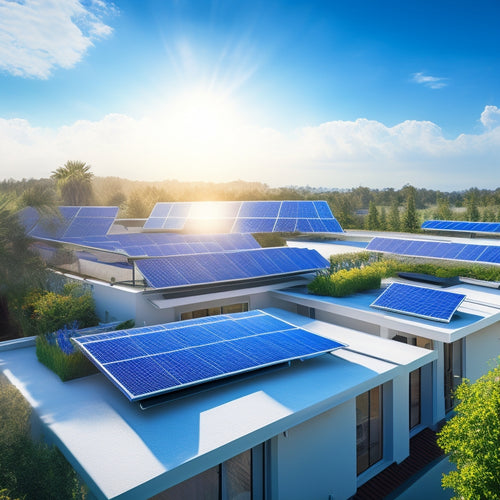
How to Set Up Solar Power Home Battery Storage
Share
You'll need to understand how solar power systems work, choosing the right battery type, and sizing your battery storage needs based on your daily energy usage. Select a compatible inverter and install the battery storage unit in a well-ventilated area, following electrical safety standards. Connect your solar panels, ensuring compatibility and proper electrical connections. Monitor and maintain performance, tracking metrics like state of charge and temperature. As you set up your solar power home battery storage system, you'll want to evaluate factors like energy efficiency, warranty options, and load management strategies to optimize your energy independence and get the most out of your investment.
Key Takeaways
- Choose the right battery type, considering factors such as lifespan, maintenance, cost, and environmental impact to ensure a suitable fit for your needs.
- Calculate your daily energy usage to determine the required battery storage capacity, and consider energy efficiency measures to reduce overall consumption.
- Select a compatible inverter that matches your battery storage unit and solar panel array specifications, with high efficiency ratings and monitoring capabilities.
- Ensure proper installation of the battery storage unit, including correct wiring, placement in a well-ventilated area, and adherence to safety codes and regulations.
- Regularly monitor and maintain your battery storage system to prolong its lifespan, including tracking performance metrics, conducting inspections, and updating software.
Understanding Solar Power Systems
When you decide to invest in solar power, understanding how solar power systems work is vital.
Solar energy basics involve capturing energy from the sun and converting it into electrical energy. This is achieved through photovoltaic technology, which uses solar panels to generate electricity. These panels are made up of photovoltaic cells that convert sunlight into direct current (DC) electricity.
The DC electricity is then sent through an inverter, which converts it into alternating current (AC) electricity, making it usable in your home. The AC electricity is then fed into your electrical panel, where it powers your appliances and lights.
Any excess energy produced is fed back into the grid through a process called net metering, and you receive credit for the excess energy produced.
Understanding how solar power systems work is vital in determining the right system size and configuration for your specific energy needs.
Choosing the Right Battery Type
You'll likely need a home battery storage system to maximize your solar power investment, and choosing the right battery type is vital.
Two popular options are lithium-ion and lead-acid batteries. Lithium-ion batteries are more expensive, but they offer a longer lifespan (10-15 years) and higher discharge rates, making them ideal for daily cycling.
Lead-acid batteries, on the other hand, are more affordable but have a shorter lifespan (5-7 years) and lower discharge rates.
When making a cost analysis, consider the upfront cost, maintenance requirements, and environmental impact of each option.
Lithium-ion batteries require minimal maintenance, while lead-acid batteries need regular watering and equalization.
Temperature effects also play a role, as high temperatures can reduce battery lifespan.
Charging cycles are another significant factor, as lithium-ion batteries can handle more cycles than lead-acid batteries.
Warranty options also vary, with some manufacturers offering up to 10-year warranties on lithium-ion batteries.
Sizing Your Battery Storage Needs
You'll need to ascertain your energy requirements to size your battery storage correctly.
This involves calculating your daily energy usage in kilowatt-hours (kWh) to guarantee your battery can meet your needs.
You'll also need to take into account the battery storage capacity, which is typically measured in kWh, to select a battery that can store enough energy for your home.
Determining Energy Requirements
To accurately size your battery storage needs, investigate your energy usage patterns and calculate your daily energy requirements. Analyze your past electricity bills to identify your energy consumption patterns, including peak usage times and overall daily energy needs. This information will help you determine how much energy you need to store to meet your requirements.
Consider implementing energy efficiency measures to reduce your energy consumption. This can include upgrading to energy-efficient appliances, installing LED lighting, and optimizing your HVAC system.
Load management strategies can also help you manage your energy usage, ensuring that you're not overloading your battery storage system.
If you're considering off-grid living or backup power solutions, you'll need to factor in additional energy requirements. Renewable energy incentives may also impact your energy usage patterns, so be sure to research these opportunities.
Battery Storage Capacity
Determine your battery storage capacity by translating your daily energy requirements into a usable unit of measurement: watt-hours (Wh). This calculation will help you size your battery storage needs accurately.
You'll want to take into account your energy usage patterns, including peak hours and low-energy periods, to determine the best battery capacity for your home.
When selecting a battery storage system, keep the following key factors in mind:
-
Battery Lifespan: A longer lifespan means fewer replacement cycles, reducing waste and environmental impact.
-
Peak Performance: Verify your battery can handle your maximum energy demands during peak hours.
-
Energy Efficiency: Opt for a system with high energy efficiency to minimize losses and maximize your solar power output.
Additionally, think about the discharge rate, charging cycles, and temperature effects on your battery's performance.
Proper maintenance tips and installation costs will also impact your overall experience.
Finally, look for warranty options that protect your investment and provide peace of mind.
Selecting a Compatible Inverter
Several key factors come into play when selecting a compatible inverter for your solar power home battery storage system.
You'll need to take into account the type of inverter that suits your system's requirements. There are three main inverter types: string inverters, microinverters, and power optimizers. String inverters are the most common, suitable for larger systems, while microinverters are ideal for smaller systems with multiple panels. Power optimizers offer a balance between the two.
Inverter efficiency is another vital factor. Look for an inverter with high efficiency ratings, typically above 95%. This guarantees that a larger portion of the generated energy is converted into usable power.
You'll also need to take into account the inverter's compatibility with your battery storage unit and solar panel array. Confirm the inverter's voltage and current ratings match your system's specifications.
Additionally, reflect on the inverter's monitoring and control capabilities. A good inverter should provide real-time monitoring and remote control features, allowing you to track your system's performance and make adjustments as needed.
Installing the Battery Storage Unit
You'll need to carefully plan the installation of your battery storage unit, starting with placement in a well-ventilated area that's easily accessible for maintenance.
Next, you'll focus on battery wiring essentials, ensuring that all connections are secure and meet electrical safety standards.
Battery Unit Placement
Your solar power home battery storage system's battery unit placement is critical to its overall performance, safety, and longevity.
The placement of the battery unit can greatly impact its ability to store and supply power efficiently.
When deciding where to place your battery unit, consider the following factors to guarantee peak performance:
-
Proper Ventilation: Guarantee good airflow around the battery unit to prevent overheating, which can lead to reduced performance and lifespan.
-
Temperature Regulation: Keep the battery unit away from extreme temperatures (above 85°F or below 32°F) to maintain its peak operating range.
-
Accessibility and Monitoring: Place the battery unit in an easily accessible location, allowing for regular maintenance and monitoring of its performance.
Battery Wiring Essentials
As the battery unit is properly positioned, attention turns to connecting it to the solar power system, which requires careful planning and execution of the battery wiring.
You'll need to verify that your wiring diagram accurately reflects the specific requirements of your battery type, whether it's lead-acid, lithium-ion, or another technology.
Consult your manufacturer's instructions for specific guidance on wiring your battery storage unit. Typically, you'll need to connect the positive and negative terminals of the battery to the corresponding terminals on the inverter/charger unit.
It's crucial to correctly identify the positive and negative cables to avoid damage or electrical shock.
Use wiring diagrams to verify your connections, and double-check that all connections are secure and meet electrical safety standards.
Properly label and organize your wiring to provide easy maintenance and troubleshooting in the future.
Remember to follow all safety precautions when working with electrical systems, and consider consulting a licensed electrician if you're unsure about any aspect of the wiring process.
Mounting the Battery Safely
One essential aspect of installing a solar power home battery storage system is mounting the battery safely and securely.
You'll want to verify that your battery is protected from physical damage, moisture, and extreme temperatures.
When selecting a mounting option, consider the following:
- Avoid direct sunlight: High temperatures can reduce the battery's lifespan and efficiency.
- Keep it away from water: Moisture can lead to corrosion and short circuits.
- Protect it from physical damage: A sturdy mounting system will prevent the battery from being knocked over or crushed.
You'll need to choose a mounting option that suits your specific battery and installation requirements.
Popular options include wall-mounted brackets, floor-standing cabinets, and outdoor enclosures.
Be sure to follow the manufacturer's guidelines for mounting and installation to verify battery safety and ideal performance.
Connecting to Your Solar Panels
With your solar power system installed, the next essential step is integrating it with your home battery storage. This connection is vital to utilizing the energy generated by your solar panels and storing it in your battery for later use.
To guarantee a seamless connection, you'll need to take into account solar panel compatibility with your battery storage system. Check the manufacturer's guidelines for compatible solar panel systems and battery storage capacities.
Before connecting your solar panels to the battery, review the installation guidelines provided by the manufacturer. These guidelines will outline the required electrical connections, wiring, and safety protocols.
Verify that your solar panel system is properly sized to match the capacity of your battery storage system. A mismatch can lead to inefficient energy storage or even system damage.
Once you've confirmed compatibility and reviewed the guidelines, proceed with connecting your solar panels to the battery storage system. This may involve installing a charge controller, inverter, or other necessary components.
Follow the manufacturer's instructions carefully to guarantee a safe and efficient connection.
Monitoring and Maintaining Performance
Now that your solar panel system is connected to your home battery storage, you're ready to confirm the system is operating at peak performance.
To do this, you'll need to monitor and maintain your system's performance regularly. This involves tracking your battery's performance metrics, such as state of charge, voltage, and temperature, to guarantee ideal efficiency.
Regular monitoring allows you to identify potential issues before they become major problems, reducing downtime and prolonging your battery's lifespan.
Some key maintenance tips to keep in mind include:
- Regular inspections of your system to detect any signs of wear or damage
- Keeping your battery storage unit clean and free of debris to promote proper airflow
- Updating your monitoring system's software regularly to ensure you have access to the latest features and performance improvements
Ensuring Safe and Efficient Operation
Each day, your solar power home battery storage system relies on several vital components working in harmony to guarantee safe and efficient operation. You must verify that these components meet strict safety standards to prevent any risks or hazards.
Efficient operation is essential, and this can be achieved through proper battery management, which involves monitoring and controlling the charging and discharging of your batteries.
To prevent fires, you should implement fire prevention measures, such as installing smoke detectors and verifying proper ventilation in the storage area.
System integration is also fundamental, as it allows your solar power system to work seamlessly with your home's electrical grid. Conduct a risk assessment to identify potential hazards and develop emergency protocols to address them.
Frequently Asked Questions
Can I Use Solar Power Storage to Charge My Electric Vehicle?
You can use solar power storage to charge your electric vehicle, but consider your battery capacity and solar charging capabilities to guarantee a sufficient supply, as it'll impact your vehicle's range and charging time.
Are Solar Power Batteries Compatible With Generators?
As you're already considering solar power for your EV, it's no coincidence you're wondering about generator compatibility. Luckily, most solar power batteries are designed for seamless battery generator compatibility, ensuring smooth solar generator integration and backup power when you need it.
Do Solar Batteries Work During a Grid Outage at Night?
You'll be glad to know that solar batteries can provide power during a grid outage at night, thanks to their stored energy, ensuring battery efficiency and granting you grid independence, even in the darkest hours.
Can I Add More Batteries to My System in the Future?
As you build your energy fortress, you'll want to know that you can reinforce it later; fortunately, you can expand your battery arsenal through future upgrades, making battery expansion a key consideration in your long-term energy strategy.
Do Solar Power Batteries Need to Be Replaced Periodically?
You'll need to replace your solar power batteries periodically, as their lifespan averages 10-15 years, depending on maintenance requirements, usage, and quality; regular checks and balancing can help extend their life, but eventual replacement is inevitable.
Related Posts
-

Why Electric Motorcycles Fail at Long-Distance Touring
You're likely familiar with the excitement of hitting the open road on an electric motorcycle, but you're also smart ...
-

Step-by-Step Guide to Converting Your Vehicle to EV
You'll begin by evaluating your vehicle's conversion potential, analyzing its weight, aerodynamics, and powertrain co...
-

Best Solar Panel Options for Maximum Energy Savings
You can maximize your energy savings with solar panels that boast efficiency ratings above 20%, paired with extensive...


